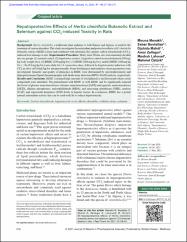| dc.contributor.author | Menakh, Mouna | |
| dc.contributor.author | Boutellaa, Saber | |
| dc.contributor.author | Mahdi, Djahida | |
| dc.contributor.author | Zellagui, Amar | |
| dc.contributor.author | Lahoue, Mesbah | |
| dc.contributor.author | Öztürk, Mehmet | |
| dc.date.accessioned | 2022-01-14T07:06:31Z | |
| dc.date.available | 2022-01-14T07:06:31Z | |
| dc.date.issued | 2021 | en_US |
| dc.identifier.citation | Menakh M, Boutellaa S, Mahdi D, Zellagui A, Lahouel5 M, Öztür k M.Hepatoprotective effects of Hertia cheirifolia butanolic extract and selenium against CCl4-induced toxicity in rats. J Rep Pharm Sci 2021;10:216-24. | en_US |
| dc.identifier.issn | 23221232 | |
| dc.identifier.uri | https://hdl.handle.net/20.500.12809/9761 | |
| dc.description.abstract | Background: Hertia cheirifolia, a traditional plant endemic to both Tunisia and Algeria, is used for the treatment of various disorders. This study investigates the antioxidant and protective effects of H. cheirifolia butanolic extract (BEHC) alone and combined with selenium (Se) against carbon tetrachloride (CCl 4)-induced liver damage in rats. Experimental Procedure: Thirty male Wistar rats were randomly divided into six groups: (1) normal control, (2) hepatotoxic control, (3) positive control received silymarin 100 mg/kg body weight (bw), (4) BEHC (100 mg/kg bw), (5) BEHC (400 mg/kg bw), and (6) BEHC (400 mg/kg bw) + Se (0,3 mg/kg bw) once daily for 14 consecutive days, followed by hepatotoxicity induction with CCl 4 in olive oil 0.6 mL/kg bw intraperitoneally. Some biochemical and oxidative stress parameters were investigated. Quantity and quality of phenolics in BEHC were determined by spectrophotometer and high-performance liquid chromatography with diode-array detection (HPLC-DAD) analysis, respectively. Results and Conclusion: BEHC contained high amounts of total phenolics and flavonoids where seven compounds were identified. The pretreatment with BEHC or with BEHC and Se significantly reduced the levels of plasma aminotransferases (alanine aminotransferase [AST] and aspartate aminotransferase [ALT]), alkaline phosphatase, malondialdehyde (MDA), and increasing glutathione (GSH), catalase (CAT), and superoxide dismutase (SOD) levels in hepatic tissues. In conclusion, BEHC has a potent natural antioxidant activity that can be used with Se to reduce hepatotoxicity. | en_US |
| dc.item-language.iso | eng | en_US |
| dc.publisher | Wolters Kluwer Medknow Publications | en_US |
| dc.relation.isversionof | 10.4103/jrptps.JRPTPS_25_20 | en_US |
| dc.item-rights | info:eu-repo/semantics/openAccess | en_US |
| dc.subject | Carbon tetrachloride | en_US |
| dc.subject | Hepatotoxicity in rat | en_US |
| dc.subject | Hertia cheirifolia | en_US |
| dc.subject | Oxidative stress | en_US |
| dc.subject | Selenium | en_US |
| dc.title | Hepatoprotective effects of Hertia cheirifolia butanolic extract and selenium against CCl4-induced toxicity in rats | en_US |
| dc.item-type | article | en_US |
| dc.contributor.department | MÜ, Fen Fakültesi, Kimya Bölümü | en_US |
| dc.contributor.authorID | 0000-0001-8932-4535 | en_US |
| dc.contributor.institutionauthor | Öztürk, Mehmet | |
| dc.identifier.volume | 10 | en_US |
| dc.identifier.issue | 2 | en_US |
| dc.identifier.startpage | 216 | en_US |
| dc.identifier.endpage | 224 | en_US |
| dc.relation.journal | Journal of Reports in Pharmaceutical Sciences | en_US |
| dc.relation.publicationcategory | Makale - Uluslararası Hakemli Dergi - Kurum Öğretim Elemanı | en_US |


















